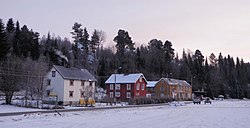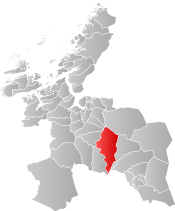Singsås (municipality)
Singsås herred
Singsaas | |
|---|---|
 View of the village of Singsås | |
 Sør-Trøndelag within Norway | |
 Singsås within Sør-Trøndelag | |
| Coordinates: 62°57′22″N 10°43′51″E / 62.9562°N 10.7308°ECoordinates: 62°57′22″N 10°43′51″E / 62.9562°N 10.7308°E | |
| Country | Norway |
| County | Sør-Trøndelag |
| District | Gauldalen |
| Established | 1841 |
| Disestablished | 1 Jan 1964 |
| Administrative centre | Singsås |
| Area | |
| • Total | 767 km2 (296 sq mi) |
| *Area at municipal dissolution. | |
| Population (1964) | |
| • Total | 1,554 |
| • Density | 2.0/km2 (5.2/sq mi) |
| Demonym(s) | singsåsbygg[1] |
| Time zone | UTC+01:00 (CET) |
| • Summer (DST) | UTC+02:00 (CEST) |
| ISO 3166 code | NO-1646 |
| Preceded by | Holtaalen in 1841 |
| Succeeded by | Midtre Gauldal in 1964 |
Singsås is a former municipality in the old Sør-Trøndelag county, Norway. The 767-square-kilometre (296 sq mi) municipality existed from 1841 until its dissolution in 1964. Singsås municipality encompassed the eastern part of what is now the municipality of Midtre Gauldal in Trøndelag county. The administrative center was the village of Singsås, where the Singsås Church is located.[2]
History[]
In 1841, the western district (population: 1,272) of the old municipality of Holtaalen was split off to form a separate municipality called Singsaas (under the recently passed formannskapsdistrikt law). On 1 January 1875, an unpopulated area of Singsås municipality made up of rural farmland and mountains was transferred to the neighboring municipality of Budal. During the 1960s, there were many municipal mergers across Norway due to the work of the Schei Committee. On 1 January 1964, the municipalities of Budal (population: 529), Singsås (population: 1,554), Soknedal (population: 1,916), and Støren (population: 2,296) were all merged to form the new municipality of Midtre Gauldal.[3]
Government[]
All municipalities in Norway, including Singsås, are responsible for primary education (through 10th grade), outpatient health services, senior citizen services, unemployment and other social services, zoning, economic development, and municipal roads. The municipality is governed by a municipal council of elected representatives, which in turn elects a mayor.[4]
Municipal council[]
The municipal council (Herredsstyre) of Singsås was made up of representatives that were elected to four year terms. The party breakdown of the final municipal council was as follows:
| Party Name (in Norwegian) | Number of representatives | |
|---|---|---|
| Labour Party (Arbeiderpartiet) | 8 | |
| Christian Democratic Party (Kristelig Folkeparti) | 2 | |
| Centre Party (Senterpartiet) | 5 | |
| Liberal Party (Venstre) | 2 | |
| Total number of members: | 17 | |
| Party Name (in Norwegian) | Number of representatives | |
|---|---|---|
| Labour Party (Arbeiderpartiet) | 8 | |
| Joint List(s) of Non-Socialist Parties (Borgerlige Felleslister) | 9 | |
| Total number of members: | 17 | |
| Party Name (in Norwegian) | Number of representatives | |
|---|---|---|
| Labour Party (Arbeiderpartiet) | 8 | |
| Joint List(s) of Non-Socialist Parties (Borgerlige Felleslister) | 8 | |
| Total number of members: | 16 | |
| Party Name (in Norwegian) | Number of representatives | |
|---|---|---|
| Labour Party (Arbeiderpartiet) | 8 | |
| Joint List(s) of Non-Socialist Parties (Borgerlige Felleslister) | 8 | |
| Total number of members: | 16 | |
| Party Name (in Norwegian) | Number of representatives | |
|---|---|---|
| Labour Party (Arbeiderpartiet) | 8 | |
| Joint List(s) of Non-Socialist Parties (Borgerlige Felleslister) | 8 | |
| Total number of members: | 16 | |
| Party Name (in Norwegian) | Number of representatives | |
|---|---|---|
| Labour Party (Arbeiderpartiet) | 8 | |
| Joint List(s) of Non-Socialist Parties (Borgerlige Felleslister) | 8 | |
| Total number of members: | 16 | |
See also[]
References[]
- ^ "Navn på steder og personer: Innbyggjarnamn" (in Norwegian). Språkrådet.
- ^ Rosvold, Knut, ed. (2017-08-29). "Singsås – tidligere kommune". Store norske leksikon (in Norwegian). Kunnskapsforlaget. Retrieved 2018-01-21.
- ^ Jukvam, Dag (1999). "Historisk oversikt over endringer i kommune- og fylkesinndelingen" (PDF) (in Norwegian). Statistisk sentralbyrå.
- ^ Hansen, Tore, ed. (2016-05-12). "kommunestyre". Store norske leksikon (in Norwegian). Kunnskapsforlaget. Retrieved 2020-02-02.
- ^ "Kommunevalgene og Ordførervalgene 1959" (PDF) (in Norwegian). Oslo: Statistisk sentralbyrå. 1960. Retrieved 2020-04-20.
- ^ "Kommunevalgene og Ordførervalgene 1955" (PDF) (in Norwegian). Oslo: Statistisk sentralbyrå. 1957. Retrieved 2020-04-20.
- ^ "Kommunevalgene og Ordførervalgene 1951" (PDF) (in Norwegian). Oslo: Statistisk sentralbyrå. 1952. Retrieved 2020-04-20.
- ^ "Kommunevalgene og Ordførervalgene 1947" (PDF) (in Norwegian). Oslo: Statistisk sentralbyrå. 1948. Retrieved 2020-04-20.
- ^ "Kommunevalgene og Ordførervalgene 1945" (PDF) (in Norwegian). Oslo: Statistisk sentralbyrå. 1947. Retrieved 2020-04-20.
- ^ "Kommunevalgene og Ordførervalgene 1937" (PDF) (in Norwegian). Oslo: Statistisk sentralbyrå. 1938. Retrieved 2020-04-20.
- Midtre Gauldal
- Former municipalities of Norway
- 1841 establishments in Norway
- 1964 disestablishments in Norway


